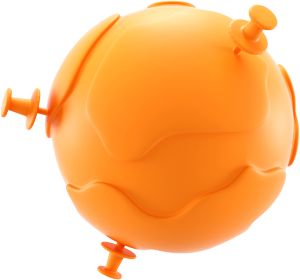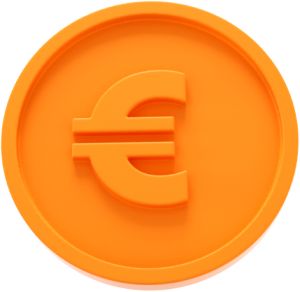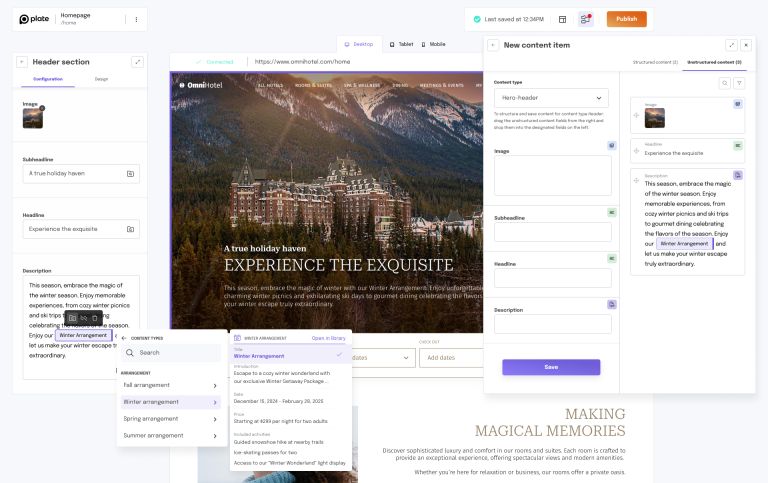One system, Your way: Creative Freedom meets Structured Control
Whether you prefer a creative editor or structured library, Plate Delta works your way.

Start with flexible, unstructured content in the editor. Shape it into structured content when you’re ready. Delta’s intelligent pattern recognition makes content management efficient, ensures seamless connections, and enables easy reuse and personalization.
Start with flexible, unstructured content in the editor. Shape it into structured content when you’re ready. Delta’s intelligent pattern recognition makes content management efficient, ensures seamless connections, and enables easy reuse and personalization.
Boost Your ContentOps: Smart, Powerful, Reusable.
Backed by 10 years of CMS expertise and over 1,500 implementations - a CMS crafted not only by experts but especially for savvy Content Editors like you.
Auto-pilot structuring to boost content reuse
Everyone dislikes repetitive tasks. The answer? Smart content structuring. In the editor, you can organize (structure) content yourself or reuse previously structured content without needing to update it in multiple places later. Delta safeguards the quality and consistency of your content and proactively suggests improvements.


Super simpel: Zero Learning Curve
All of these powerful features, with zero technical skills required. Delta feels immediately familiar and is as easy to edit as an inline website builder, with the strength of a robust CMS under the hood but none of the complex interfaces.

Multi-Channel Content
With our headless CMS, you can deploy content visually across different content experiences, allowing for unique, centrally managed experiences. Delta seamlessly connects to any front-end, giving you full control over content and user experience—no matter the platform or channel.
An unparalleled feature combination
Plate Delta removes the frustration often faced by Content Editors striving to work smart and efficiently with large volumes of content. It is engineered to empower editors with the autonomy to manage content effortlessly and productively.



Why Choose Plate Delta
Plate Delta is ideal for organizations with a centrally managed marketing team and 500 to 1500 pages in their current CMS. Are you using Drupal, WordPress, or a headless CMS that isn’t meeting your needs? Delta is the solution. Curious about costs or have other questions? Check the licensing prices, view the FAQ below, or send us a message.
Tame Content Chaos
Download our free whitepaper, “The Hidden Costs of Content Chaos,” and learn how structured content can make your website more efficient, consistent, and effective.
Your Questions, Answered
Can I try Plate Delta before committing?
Yes, you can! We offer free trials and demos of Plate Delta so you can explore its features and see how it fits your needs. Our team is also available to guide you through the platform and answer any questions during the trial period.
What are the differences between Plate Multisite and Plate Delta?
Plate Multisite is a robust CMS specifically designed for efficiently managing multiple websites within a single hosted central system. As a developer, you’ll work within our front-end frameworks, optimized to deliver the best multisite solution with consistency and reliability across all sites.
Plate Delta, on the other hand, is a Headless CMS that provides developers with the freedom to choose their preferred front-end frameworks. It serves as a foundation for content editors while introducing advanced features such as flexible content structuring, smart detection and suggestions, and future-ready tools like enhanced personalization capabilities. Delta is the ideal choice for organizations requiring advanced capabilities and scalability for managing large volumes of content across diverse needs.
Can I, as an agency or SI resell Plate Delta?
Yes! Plate Delta is agency-friendly and can be seamlessly integrated into your service offerings. As a reseller, you’ll gain access to tools, training, and support to help your clients succeed with Delta, all while keeping your branding and client relationships intact. Plus, you’ll receive a fair kickback fee on the license fee for as long as the customer remains with you. It’s a win-win partnership!
Is Plate Delta a Hosted CMS?
Yes, Plate Delta is a hosted CMS. We take care of the backend, ensuring speed, security, and reliability, while giving you full freedom over the frontend. Content is served quickly and efficiently through a public API, so you can build your frontend exactly the way you want it. It’s the best of both worlds—managed hosting with complete developer flexibility.
Do I need technical skills to use Plate Delta?
Plate Delta is designed to be intuitive and user-friendly, featuring a zero-learning-curve interface that empowers content editors to manage and structure content effortlessly while maintaining consistency and quality. At the same time, it balances simplicity for editors with the advanced capabilities developers need to handle complex configurations.
As a Headless CMS, Plate Delta gives developers the freedom to work with their preferred frontend frameworks, allowing full flexibility in building projects. And when support is needed, our team is always ready to assist, ensuring a seamless experience for both content editors and developers.
How does Plate Delta ensure content security and compliance?
Plate Delta is built with security and compliance at its core. It includes access controls, automated product updates, and GDPR compliance by default. Our infrastructure is hosted on AWS, ensuring world-class security standards, and we proactively monitor and improve our systems to protect your content.
Ready to outsmart your content challenges?
All jokes aside, we’re not here to take over your job—we’re here to make it smarter. Plate Delta is designed to boost your content efficiency and creativity, not replace it. Want to see how it works for you? Book a tailored demo now and experience the difference firsthand. Your smarter content journey starts here!













